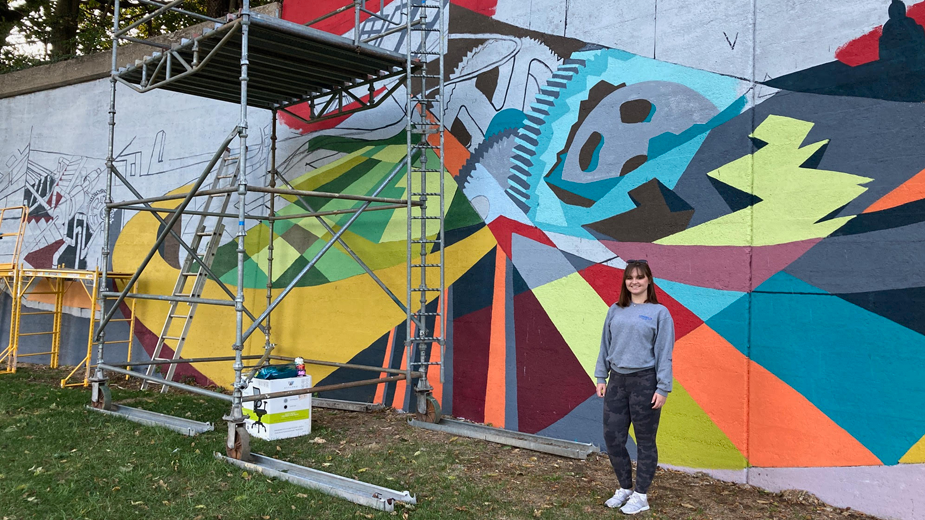Mural Depicting Youngstown’s Past and Future Taking Shape
YOUNGSTOWN, Ohio – An ambitious mural that encompasses the city’s past, present and future has begun to reveal itself.
Visually abstract but based on the memories of local residents, the mural on the edge of downtown is peppered with the landmarks and icons of the Mahoning Valley. Viewers will spot the gears of heavy industry, the Premier Bank tower, Lanterman’s Mill and the Idora Park sign.
More abstract are depictions of the dance floor of The Elms ballroom, which once stood where Youngstown State University’s student union is now, and the lunch counter in a long-gone downtown department store.
The 160-foot-long mural, along Andrews Avenue just north of East Federal Street, was designed by Youngstown State University students in a public art class being taught by professor Dragana Crnjak.
It’s about halfway complete, and Crnjak said it will be finished by the end of the month.
Her class solicited memories and ideas from the public and incorporated them into the design.
Crnjak has split her 12-student class into two groups who take turns working on it. A 12-foot scaffold at the site allows them to reach the top of the 20-foot wall. Crnjak and some of her students were at the site Monday to continue their work.
Rachel Hritz, a junior with a double major in art education and painting, described the mural as a collaborative effort among everyone in the class.
“We started by getting pictures from the [Mahoning Valley Historical Society] and projected them on to a large sheet of paper,” said the Boardman resident. “We sketched the bigger shapes that were inspiring us and further broke down those areas into different things that we wanted to incorporate into the mural. I’m happy with how it’s turning out, juxtaposing past memories with our hopes for the future.”
Naturally, the steel industry and how it shaped the city dominates many of the memories, Hritz said. But the leisure side of how we once lived is also represented.
“We incorporated a film reel to show the theaters that were really popular downtown back in the day,” Hritz said, “along with the exterior of the Strouss’ department store building and a lunch counter to show how the interior would have been.”
The Mahoning River will run through the mural. “We wanted to show the process of cleaning up the river, so it will be transitioning colors to show it has become cleaner and greener,” Hritz said.
The mural, Hritz pointed out, is not chronological in the way it is ordered.
“Everything is blended,” she said. “We did originally think about doing a timeline but we wanted to have the different areas of time play off each other.”
Rose Rivera, a senior from Boardman, said the class wanted the mural to represent both the past and the future but in a unique way.
“We didn’t want it to be too representational,” she said. “We didn’t want it to look like a conventional mural. We wanted to liven up this road and also stand out. You see a lot of abstraction and the color and light that Youngstown has.”
The size of the wall called for certain techniques and procedures.
“There being such a large surface to cover, we first had to sketch it on paper,” Rivera said. “We then project it onto the wall [at night] to trace the outlines of the design, and during day we fill in the outlines with color.”
Rivera, who is majoring in interdisciplinary studio arts with a double minor in international business and Asian studies, said the class wanted to convey the feeling of the city and its people.
Crnjak said the canvas – an old concrete wall – posed challenges of its own.
“The wall is uneven and porous,” she said. “We used twice as much primer than we anticipated.”
Moving the scaffold has been a team effort. “There are 12 women in this class,” Crnjak. “No men enrolled. We have to team up to push the scaffold.”
The students had to keep the viewer in mind when designing the artwork.
“The mural is on a busy street and 90 percent of those who see it will be viewing it from a passing car, so we wanted it to be dynamic,” she said. “Details won’t be visible from afar but if you do stop you will see other things.”
Crnjak said she hopes the city makes the large grassy area in front of the mural more pedestrian friendly, and adds benches. At both ends of the 160-foot mural, logos of the organizations and companies that supported the project will be painted.
The project will continue in the fall of 2021 when Crnjak’s next public art class will paint an area just south of the current mural.
The project is a partnership between Lit Youngstown and the YSU art department. A website offers background information about it; go to Mural.ysu.edu.
The project is being supported by Youngstown Cityscape and the Andrews Avenue Business Group, with the help of a $5,000 Neighborhood Success Grant from the Raymond J. Wean Foundation.
Pictured: YSU student Rachel Hritz is among the dozen students working with professor Dragana Crnjak to create the mural on Andrews Avenue.
Copyright 2024 The Business Journal, Youngstown, Ohio.



